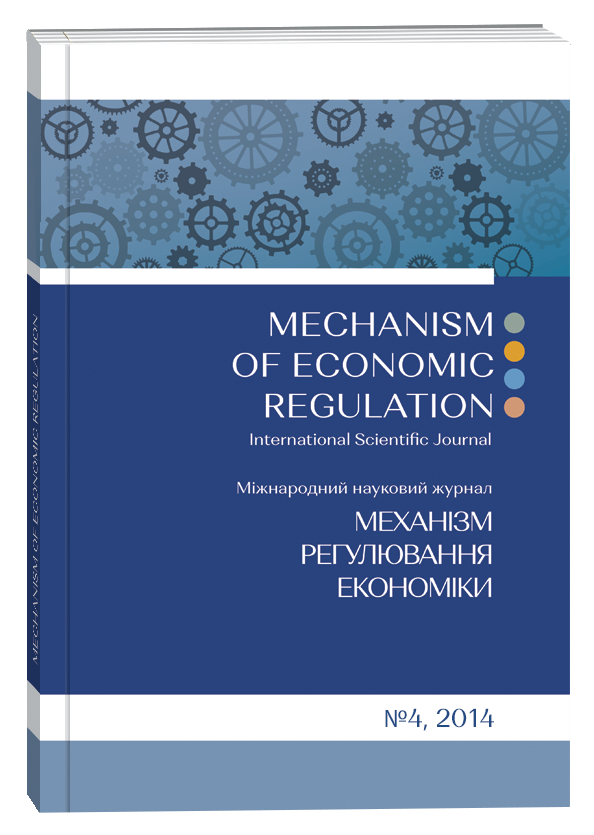MANAGEMENT OF CAPITALIZATION OF ENTERPRISES THROUGH HARMONIZATION OF STAKEHOLDERS INTERACTIONS
Abstract
In the current economic conditions for planning of the company and developing a strategy to help account not only the interests of shareholders, but also to the other participants, that is, all the stakeholders. In the article the interests of stakeholders in the aspect of providing capitalization company were systematized. The main types of conflicts between different groups of stakeholders were developed. In view of the differences between the interests of different stakeholder groups and the possible contradictions between the interests of stakeholders according to the degree of influence on the company, stakeholders are defined the direct impact and remote stakeholders (often indirect) effects were classified. By the level of interest of stakeholders in the company's capitalization and the level of their impact on the capitalization by allocating distinct groups among all stakeholders to construct a matrix of stakeholders capitalization of the company. A typology of stakeholder groups was made. By combining the three types of interaction between business owners and small shareholders and the three forms of market efficiency was allocated 9 types of business attraction and construct a matrix of shareholders' interests. Suggestions for growth indicator EBITDA were developed.
References
Булеев, И. П. Институциональные аспекты стратегии капитализации предприятий / И. П. Булеев, Н. Е. Брюховецкая // Економічний вісник Донбасу. – 2010. – № 1. – С. 25–29. 2. Ивашковская, И. В. Финансовые измерения корпоративных стратегий. Стейкхолдерский подход / И. В. Ивашковская. – М. : ИНФРА-М, 2008. – 257с.
Клейнер, Г. Эволюция и реформирование промышленных предприятий: 10 лет спустя / Г. Клейнер // Вопросы экономики. – 2000. – № 5. – С. 62–74.
Формы эффективности рынка [Електронний ресурс] // Информационный портал об инвестициях и инвестиционных инструментах «Финансовые инвестиции – образовательный центр» – Режим доступу : http://allfi.biz/investingbasics/BasicConcepts/formy-jeffektivnosti-rynka.php.
Acquier, A. From stakeholder to stakeholder management in crisis episodes: A case study in a public transportation company / A. Acquier, S. Gand, M. Szpirglas // Journal of Contingencies and Crisis Management. – 2008. – № 16 (2). – P. 101–114.
Barton, S. L. An empirical test of stakeholder theory predictions of capital structure / S. L. Barton, N. C. Hill, S. Sundaram // Financial Management. – 1989. – № 18 (1). – P. 36–44.
Berman, S. L., Does stakeholder orientation matter? The relationship between stakeholder management models and firm financial performance / S. L. Berman, A. C. Wicks, S. Kotha, T. M. Jones // Academy of Management Journal. – 1999. – № 42 (5). – P. 488–506.
Bryson, J. M. What To Do When Stakeholders Matter: A Guide to Stakeholder Identification and Analysis Techniques / J. M. Bryson // Public Management Review. – 2004. – Vol. 6. № 1. – P. 21–53.
Capasso, A. Stakeholder Theory and Corporate Governance: The Role of Intangible Assets / A. Capasso // European Corporate Governance Institute Magazine. – 2004. – № 10. – P. 34–46.
Charreaux, G., Corporate Governance: Stakeholder value versus Shareholder value / G. Charreaux, P. Desbrieres // Finance Controle Strategie. – 1996. – № l. – P. 17–46.
Freeman, R. E. Strategic Management: A Stakeholder Approach / R. E. Freeman. – Boston : Pitman, 1984. - 116 p.
Heath, J. Stakeholder Theory, Corporate Governance and Public Management / J. Heath, W. Norman // Journal of Business Ethics. – 2004. – Vol. 53. – P. 247–265.
Macey, J. R. Corporate stakeholders: A contractual perspective / J. R. Macey, G. P. Miller // University of Toronto Law Journal. – 1993. – № 43. – P. 401–424.
Buleev, I. P., Bryuhovetskaya, N. E. (2010), “Institutsionalnyie aspektyi strategii kapitalizatsii predpriyatiy,” EkonomIchniy visnyk Donbassu, 1, 25–29. (In Russian)
Ivashkovskaya, I. V. (2008), Financial measurement of corporate strategies. Stakeholder approach, Moscow, INFRA-M. (In Russian)
Kleyner, G. (2000). “Evolution and reform of industrial enterprises: 10 years later,” Voprosy ekonomiki, 5, 62–74. (In Russian)
Forms of Market Efficiency, http://allfi.biz/investingbasics/BasicConcepts/formy-jeffektivnosti-rynka.php. (In Russian)
Acquier, A., Gand, S., Szpirglas, М. (2008), “From stakeholder to stakeholder management in crisis episodes: A case study in a public transportation company,” Journal of Contingencies and Crisis Management, 16 (2), 101–114.
Barton, S. L., Hill, N. C., Sundaram, S. (1989), “An empirical test of stakeholder theory predictions of capital structure,” Financial Management, 18 (1), 36–44.
Berman, S. L., Wicks, A. C., Kotha, S., Jones, T. M. (1999), “Does stakeholder orientation matter? The relationship between stakeholder management models and firm financial performance,” Academy of Management Journal, 42 (5), 488–506.
Bryson, J. M. (2004), “What To Do When Stakeholders Matter: A Guide to Stakeholder Identification and Analysis Techniques,” Public Management Review, 6 (1), 21–53.
Capasso, A. (2004), “Stakeholder Theory and Corporate Governance: The Role of Intangible Assets,” European Corporate Governance Institute Magazine, 10, 34–46.
Charreaux, G., Desbrieres P. (1996), “Corporate Governance: Stakeholder value versus Shareholder value”, Finance Controle Strategie, l, 17–46.
Freeman, R. E. (1984), Strategic Management: A Stakeholder Approach, Boston, Pitman.
Heath, J., Norman, W. (2004), “Stakeholder Theory, Corporate Governance and Public Management,” Journal of Business Ethics, 53, 247–265.
Macey, J. R., Miller, G. P. (1993), “Corporate stakeholders: A contractual perspective,” University of Toronto Law Journal, 43, 401–424.


